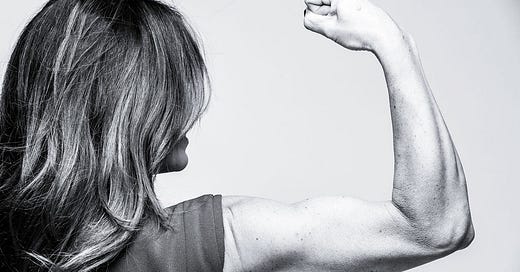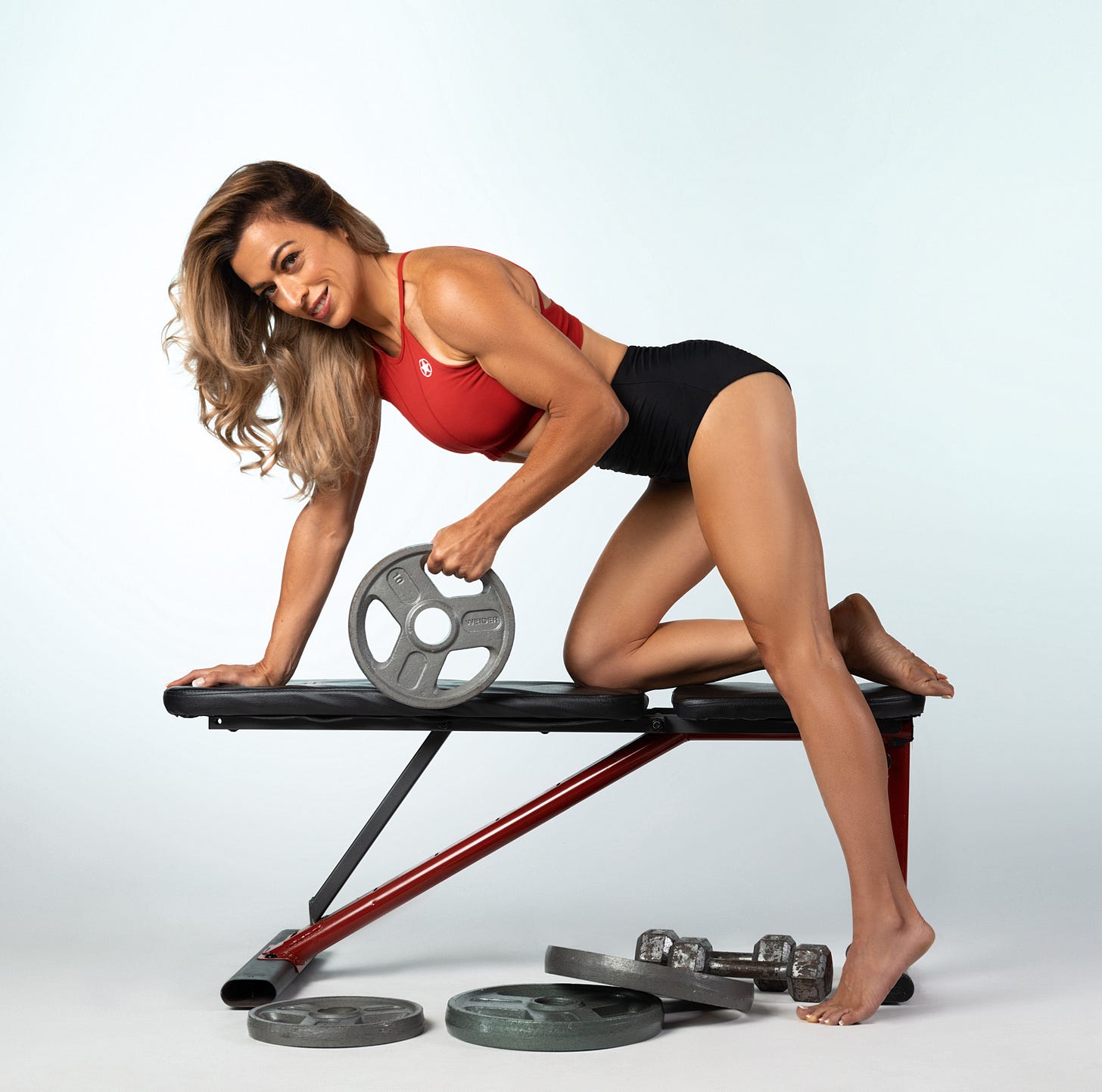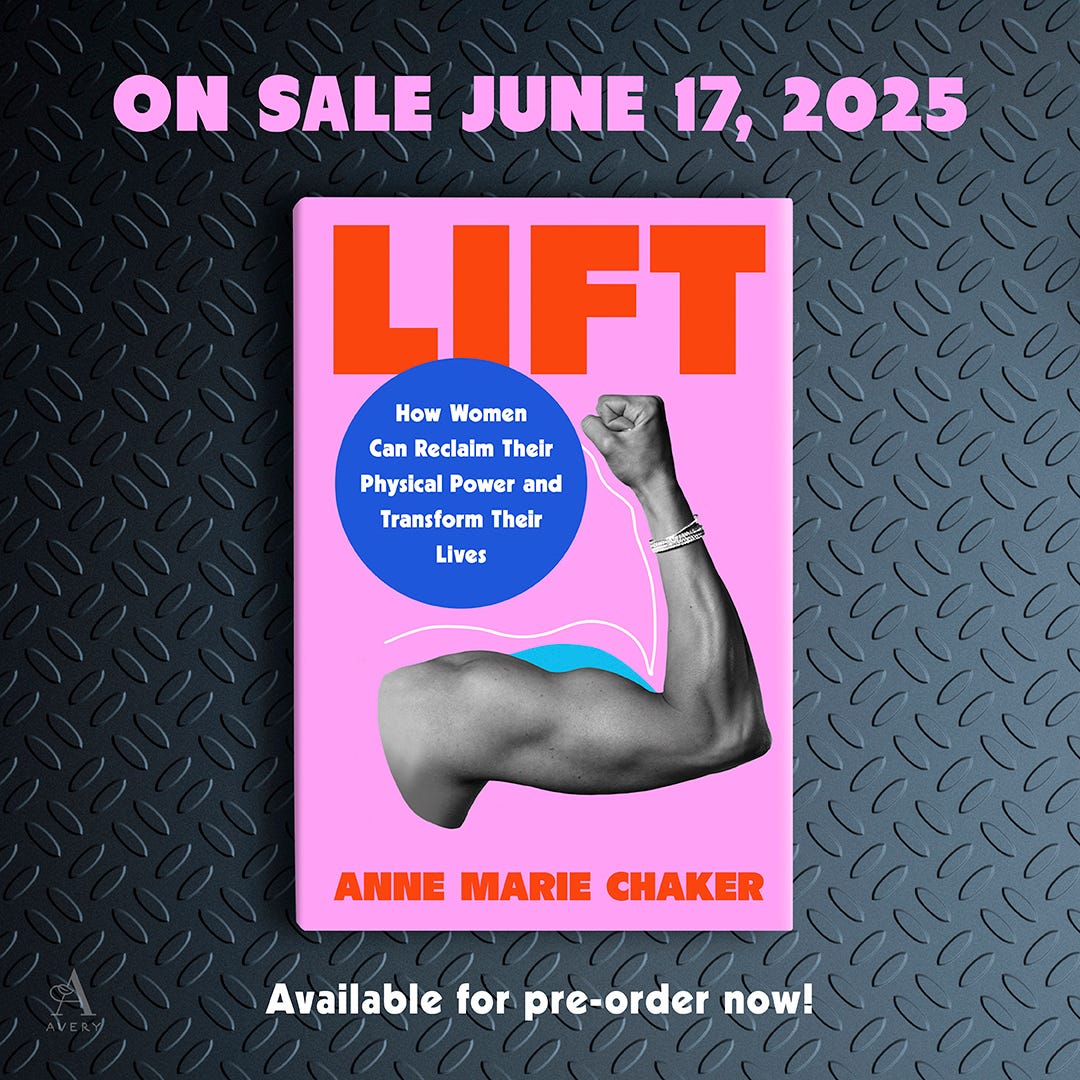In today’s post, guest writer
is bringing her no-nonsense, simple-is-best perspective to strength training in midlife. And she should know: she’s a reporter turned professional bodybuilder. Her book, Lift, is set to be released this spring and can be preordered now on her website.Here’s what she has to say to midlife women hoping to get more fit.
I’m done with dieting to be thin: I want to build strength. But where do I start?
It’s understandable to be confused. The ‘rules’ feel like they’re always changing, subject to the whims of social-media influencers and the latest viral fad. It is why many people give up before they even start. Case in point: Is it called cardio–or are we now counting steps? Do I need gadgets, monitors, a special watch? And protein: am I eating too much or not enough? What’s “bulking,” and why is everyone talking about creatine? Most importantly, how should I approach working out?
Building strength and muscle is especially important as we age, because we tend to lose a little bit of it as we get older. But if you’ve gone down the rabbit hole of how-to guides and bro-y fitness podcasts, you may have come away feeling like fitness is a rigid, macho science experiment—and that it’s not really for you. So where to begin?
1. Make it yours.
Comparison is everywhere, in fitness and life. But your journey is yours alone—it doesn’t have to look like anyone else’s. Some people thrive on gadgets and tracking, but that’s not for everyone. Personally, I don’t need to know my VO2 max; if I remember my keys, purse, and clean socks, it’s a win. My standard uniform–sports bra, leggings or shorts, and a t-shirt or tank–hasn’t changed since day one.
I keep it simple: I focus on being present during workouts, enjoying the movement, and noticing how it makes me feel mentally, emotionally, and physically. When those pieces align, I stay consistent—and consistency is the key to everything.
2. Think of exercise as something additive, not reductive.
For too long, women have been conditioned to see exercise as a way to shrink themselves; It’s no wonder the stationary bikes and ellipticals are packed with women. Women’s weightlifting is revolutionary because it’s about creating more of oneself. Muscle is beautiful. Strength is sexy. Building a body that’s dynamic, fit and strong is empowering–both physically and mentally.
When I exercise, I visualize life’s challenges as weights I’m lifting, pushing them overhead or pulling them out of my way. It’s not an “ugh” obligation. I’m not only adding strength to my body, but also adding time in the day just for me: Gym time is where I connect with others, care for myself, and find joy in the process.
And don’t forget to add a ritual. One that I love: stretching in the sauna before workouts, especially after coming in from the cold. By the time I start moving, I’m in the zone. That flow keeps me coming back.
3. Learn to lift—and build a plan.
Start simple: aim for three strength-training sessions a week. If your gym offers free personal training sessions, take advantage of them; use them to learn the basics.
Here’s a quick game plan:
Goal: Choose a structure—full-body workouts three times a week, or split days (push, pull, legs).
Each Workout: Do 5–6 exercises (about 45–60 minutes). Aim for 3 sets of 8–10 reps per exercise. Push to muscle fatigue:by your last rep, you should feel like you could only squeeze out one or two more if your life depended on it (an RPE of 8 or 9).
Cardio: Save it for after strength training to get the most from your lifting. When I finish a session, I head to the step mill—it gets my heart rate up and challenges my glutes.
4. Focus on food.
Skip the fads. Start with whole ingredients, focusing on carbs, proteins, and fats. Here’s my simple meal prep strategy:
Carbs: Cook rice, boiled potatoes (white or sweet), and keep a big green salad ready as well as other favorite veggies.
Proteins: Grill chicken, cook ground turkey (93 or 99 percent lean), and stock frozen shrimp. Keep liquid egg whites on hand for smoothies.
Fats: Incorporate healthy sources such as olive oil, avocado, or nuts.
From there, mix and match meals. You’ll eat better, save money, and keep it simple.
5. Protein is your friend.
If you’re lifting, aim for about 1 gram of protein per pound of body weight daily. Most people don’t get enough. Lean proteins—think chicken, fish, shrimp, and egg whites— are great options.
Don’t be swayed by all the prepackaged pops and bars and gummies flooding the market by promoting protein. Keep your food real and whole. (Pro tip: I save a fortune shopping at Aldi’s)
Creatine is another helpful tool. It’s not just for bros, and no, it won’t make you “bulky.” (Nothing will make you “bulky.”) A spoonful in your smoothie aids muscle repair. Add a multivitamin and calcium for a well-rounded boost.
6. Skip the ‘bulking’ buzzword.
“Bulking” is a bodybuilding term for increasing calories to build muscle during off-season training. Social media makes it sound like an all-you-can-eat fest, but it’s a highly calculated process. If you’re a competitive bodybuilder, then yes, you calculate a few hundred calories over your BMR (basal metabolic rate)--usually 10 to 20 percent over typical daily weight maintenance calories–to gain muscle mass. But this is a specific, tailored approach–usually followed by a cut or a “shred”--done for certain finite goals. I recommend you focus instead on balanced nutrition: Somewhere in the zone of 50 percent carbs, 30 percent protein, and 20 percent fats. You can download MyFitnessPal to help track your intake.
Fitness doesn’t have to be complicated. Start small, stay consistent, and focus on what makes you feel strong and happy. You’ve got this.
//
She makes it seem doable, am I right?
After talking to Anne Marie and reading all that, I’m ready to rack those weights! As a matter of fact, she promised to hold me accountable. So, I’ll be taking her up on that!
What is your biggest takeaway from this piece?
Has it inspired you to get off the cardio machines and over to the weights?
What, if anything, intimidates you about weight training?
Drop your comments below. We’ll get Anne Marie to come back and answer your most pressing questions. In the meantime, consider preordering her book. She’s also available for speaking engagements because, dang, she’s inspiring!
Become a subscriber to Lift here on Substack, and reach out to Anne Marie directly.
Your Support Matters
Can We Talk About This? is 100% reader-supported. Share it with women you know who are smack-dab in the midst of the hormone rollercoaster, body changes, and reinvention of their passion and purpose in midlife. Invite them into the conversation.
Consider becoming a paid subscriber to be included in private chats and live Zooms, plus gain access to all resources and recordings, discounts and pre-sales as available.
Let’s Promote From Within
Do you have a story to tell or a skill our community may find useful or interesting? Reach out to me for an opportunity to be featured in Can We Talk About This? Together, we grow.











This was a great read, especially learning about creatine..I never really knew before what to do with it, I did think it was more for men 🤷♀️
Coach approved article ;) Nice work!